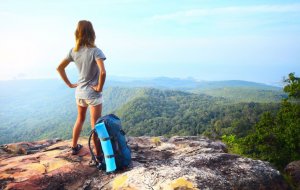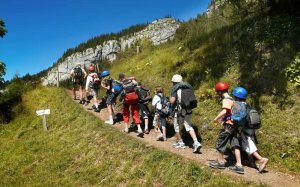What is trekking?

Do you know what trekking is? Let’s talk about what it involves and discuss how you can practice it.
What is trekking?
Trekking is a term commonly used to reference the activity that’s commonly known as hiking.
Therefore, trekking consists of walking, along natural and open routes -preferably on a mountain- to exercise and connect with nature. It’s also a way to travel and get to know new areas and places that other people may not have visited yet.

You can practice trekking by following established trails that you can find on a lot of mountains. Or doing it completely on your own, with no other guide than your sense of orientation and a compass.
You can enjoy trekking over mountains, forests, jungles, hills and even deserted islands, if they’re big enough. This kind of sport is known as ecotourism and the people that practice it are very involved and aware of the natural environment.
What are the benefits of trekking?
Trekking, depending on the type of terrain that you do it in, is a very comprehensive sport. Some trails offer so much more than just long walks. You must climb, go up or down hills or make some kind of effort that will work different parts of your legs.
However, no matter how hard the track is, trekking provides many benefits for every level, such as:
- Reducing stress and anxiety. Any workout can help with this, but if it’s a sport that you practice outdoors, the contribution is even better.
- Improves your senses.
- Improves your blood flow.
- Inner peace. This is something that happens with any sport or workout that you do in a natural environment, because you create a connection that gives you tranquility.
- Benefits your balance. Working out on stony ground will push you to make a greater effort to stay on your feet.
- Tones your muscles. Although walking isn’t considered a toning sport, doing so on mountains and hard terrains will help your muscles to tone up and your bones to become stronger.
If, after learning about trekking and analyzing its benefits you feel like practicing it, follow the next advice.
What to include in your trekking backpack
No matter how short the track is, you should carry a backpack that contains the basic supplies you’ll need to spend a day in the mountain, jungle or whatever place you chose to practice this sport in. Especially if you decide to trek for several days in a row, and even camp there.

This is what you should put in your backpack:
- Water. Depending on if you’re staying there for the whole day, just a few hours or several days, measure the amount of water that you’ll need, and include it in your trekking kit.
- Food. Do the same as with water. Measure out the amount you’ll need, so that you won’t run out. It is recommended, especially if you’ll be staying for more than one day, to pack canned food that isn’t too heavy to carry and that you don’t need to keep cool. Dried fruits, snacks and energy bars are a good choice too, as long as they don’t contain chocolate, in case it gets too hot.
- Cell phone and portable battery
- First aid kit. A small travel first aid kit can help you out in case of a minor emergency.
- Thermal blanket
- Lantern
- Burner. In case for any reason, you need to start a fire.
- Knife or blade
- Rain jacket for yourself and to cover your backpack
- Whistle. In case you get lost, or you run into an animal.
- Sunblock
- Coat. If you plan to spend more than one day on the mountain, it may get very cold at night, even if the temperature is warm during the day.
Remember to put items into waterproof bags. Beyond that, and with these basic tips you’ll be able to enjoy trekking without any incidents.
Do you know what trekking is? Let’s talk about what it involves and discuss how you can practice it.
What is trekking?
Trekking is a term commonly used to reference the activity that’s commonly known as hiking.
Therefore, trekking consists of walking, along natural and open routes -preferably on a mountain- to exercise and connect with nature. It’s also a way to travel and get to know new areas and places that other people may not have visited yet.

You can practice trekking by following established trails that you can find on a lot of mountains. Or doing it completely on your own, with no other guide than your sense of orientation and a compass.
You can enjoy trekking over mountains, forests, jungles, hills and even deserted islands, if they’re big enough. This kind of sport is known as ecotourism and the people that practice it are very involved and aware of the natural environment.
What are the benefits of trekking?
Trekking, depending on the type of terrain that you do it in, is a very comprehensive sport. Some trails offer so much more than just long walks. You must climb, go up or down hills or make some kind of effort that will work different parts of your legs.
However, no matter how hard the track is, trekking provides many benefits for every level, such as:
- Reducing stress and anxiety. Any workout can help with this, but if it’s a sport that you practice outdoors, the contribution is even better.
- Improves your senses.
- Improves your blood flow.
- Inner peace. This is something that happens with any sport or workout that you do in a natural environment, because you create a connection that gives you tranquility.
- Benefits your balance. Working out on stony ground will push you to make a greater effort to stay on your feet.
- Tones your muscles. Although walking isn’t considered a toning sport, doing so on mountains and hard terrains will help your muscles to tone up and your bones to become stronger.
If, after learning about trekking and analyzing its benefits you feel like practicing it, follow the next advice.
What to include in your trekking backpack
No matter how short the track is, you should carry a backpack that contains the basic supplies you’ll need to spend a day in the mountain, jungle or whatever place you chose to practice this sport in. Especially if you decide to trek for several days in a row, and even camp there.

This is what you should put in your backpack:
- Water. Depending on if you’re staying there for the whole day, just a few hours or several days, measure the amount of water that you’ll need, and include it in your trekking kit.
- Food. Do the same as with water. Measure out the amount you’ll need, so that you won’t run out. It is recommended, especially if you’ll be staying for more than one day, to pack canned food that isn’t too heavy to carry and that you don’t need to keep cool. Dried fruits, snacks and energy bars are a good choice too, as long as they don’t contain chocolate, in case it gets too hot.
- Cell phone and portable battery
- First aid kit. A small travel first aid kit can help you out in case of a minor emergency.
- Thermal blanket
- Lantern
- Burner. In case for any reason, you need to start a fire.
- Knife or blade
- Rain jacket for yourself and to cover your backpack
- Whistle. In case you get lost, or you run into an animal.
- Sunblock
- Coat. If you plan to spend more than one day on the mountain, it may get very cold at night, even if the temperature is warm during the day.
Remember to put items into waterproof bags. Beyond that, and with these basic tips you’ll be able to enjoy trekking without any incidents.
All cited sources were thoroughly reviewed by our team to ensure their quality, reliability, currency, and validity. The bibliography of this article was considered reliable and of academic or scientific accuracy.
- Armellini F, Zamboni M, Robbi R, Todesco T, Bissoli L, Mino A, Angelini G, Micciolo R, Bosello O. The effects of high altitude trekking on body composition and resting metabolic rate. Horm Metab Res. 1997 Sep;29(9):458-61.
- de Mol P, Fokkert MJ, de Vries ST, de Koning EJ, Dikkeschei BD, Gans RO, Tack CJ, Bilo HJ. Metabolic effects of high altitude trekking in patients with type 2 diabetes. Diabetes Care. 2012 Oct;35(10):2018-20.
- Hawke AL, Jensen RL. Are Trekking Poles Helping or Hindering Your Hiking Experience? A Review. Wilderness Environ Med. 2020 Dec;31(4):482-488.
- Kang SJ. Trekking exercise promotes cardiovascular health and fitness benefits in older obese women. J Exerc Rehabil. 2014 Aug 31;10(4):225-9.
- Mayer K, Lukács A. Motivation and mental well-being of long-distance hikers: A quantitative and qualitative approach. Heliyon. 2021 May 1;7(5):e06960.
- Niedermeier M, Einwanger J, Hartl A, Kopp M. Affective responses in mountain hiking-A randomized crossover trial focusing on differences between indoor and outdoor activity. PLoS One. 2017 May 16;12(5):e0177719.
This text is provided for informational purposes only and does not replace consultation with a professional. If in doubt, consult your specialist.








